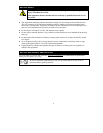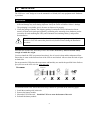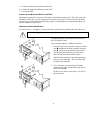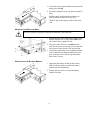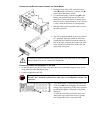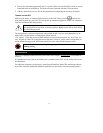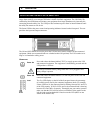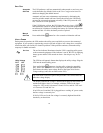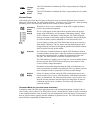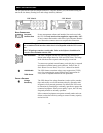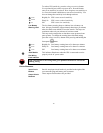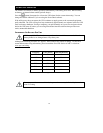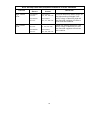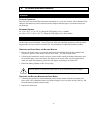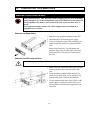
11
Voltage
Trim
This LED illuminates to indicate the UPS is compensating for a high util-
ity voltage.
Voltage
Boost
This LED illuminates to indicate the UPS is compensating for a low utility
voltage.
B
ATTERY POWER
If the utility power fails, the UPS can provide power to the connected equipment from its internal
battery for a finite period. The UPS sounds an alarm—four beeps every 30 seconds—while operating
on-battery power. The alarm stops when the UPS returns to on-line operation.
On-Battery
Power
When the on-battery power indicator is lit the UPS is supplying battery
power to the connected equipment.
Battery
Charge
The five-LED display on the right of the front panel shows the present
charge of the UPS battery as a percentage of the battery capacity. When
all five LEDs are lit, the battery is fully charged. The LEDs extinguish,
from top to bottom, as the battery capacity diminishes. Refer to the figure
at left for the battery capacity threshold (it is not listed on the UPS).
As a low battery warning, any LEDs illuminated (for the given capacity)
flash and the UPS beeps. The low battery warning default setting can be
changed from the rear panel or through the optional PowerChute software.
Refer to Default Settings in this manual.
Overload
The UPS emits a sustained alarm tone and the LED illuminates when an
overload condition occurs (that is, when the connected equipment exceeds
the specified “maximum load” as defined in Specifications at the APC
web site). The alarm remains on until the overload is removed.
The UPS continues to supply power as long as it is on-line and the breaker
does not trip; but, the UPS will not provide power from batteries in the
event of a utility voltage interruption.
Disconnect nonessential equipment from the UPS to eliminate the over-
load. If a continuous overload occurs while the UPS is on-battery, the unit
turns off output in order to protect the UPS from possible damage.
Replace
Battery
Failure of a battery self-test causes the UPS to emit short beeps for one
minute and the replace battery LED illuminates. LED flashes indicate the
battery is disconnected. The UPS repeats the alarm every five hours. Per-
form the self-test procedure after the battery has charged for 24 hours to
confirm the replace battery condition. The alarm stops if the battery
passes the self-test.
S
HUTDOWN MODE (VIA SOFTWARE OR AN ACCESSORY)
In shutdown mode, the UPS stops supplying power to the connected equipment, waiting for the re-
turn of utility power. If there is no utility power present, external devices (such as servers) connected
to the computer interface or the accessory slot can command the UPS to shut down. This normally is
done to preserve battery capacity after the shutdown of protected servers. The UPS scrolls the front
panel indicators sequentially in shutdown mode.



